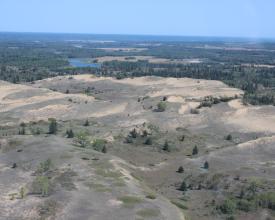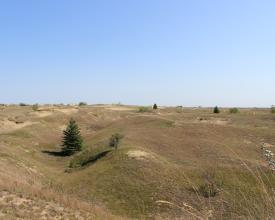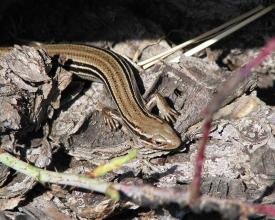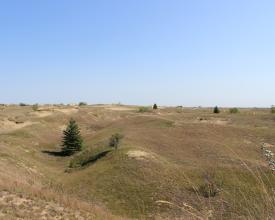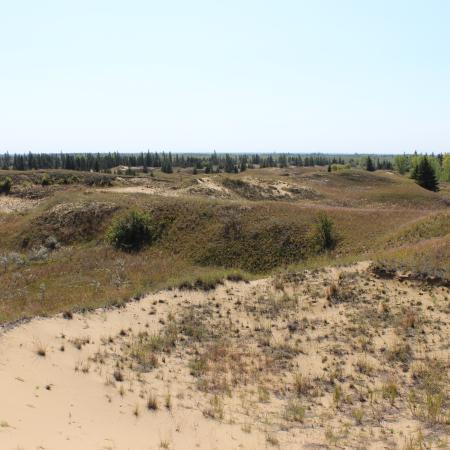
Natural areas of Canadian Forces Base Shilo recognized as an OECM
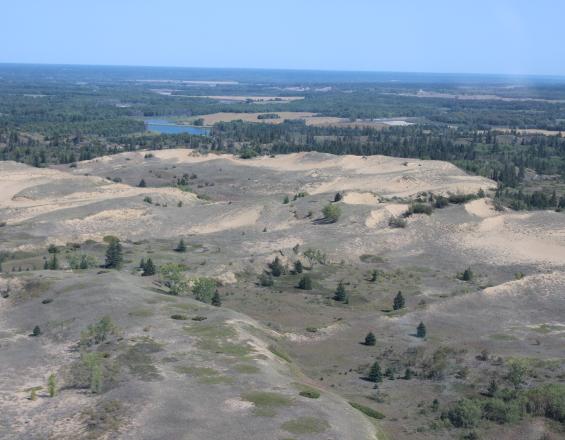
The Canadian Forces Base (CFB) Shilo is located in the mixed-grass prairie ecosystem of south-central Manitoba and is controlled by Canada’s Department of National Defence. While it is managed primarily for defence, CFB Shilo has specific secondary objectives focused on the conservation of biodiversity.
While portions of CFB Shilo have infrastructure and high human traffic, there are areas on the base that are largely natural habitats and which support diverse plant and wildlife communities. These natural areas were collaboratively assessed by the federal Department of National Defence and the provincial (sub-national) Government of Manitoba. They were found to meet all necessary conditions to be reported as an Other Effective Conservation Measure (OECM) and were reported by the Government of Manitoba for inclusion in the Canadian protected and conserved areas database.
CFB Shilo is the first Canadian military base recognized as a part of the Canadian protected and conserved areas network.
Context
Challenges addressed
The Government of Canada sees great value in recognizing good land stewardship that contributes to biodiversity conservation. As such, it is seeking to recognize all areas that conserve in-situ biodiversity for the long term and meet the definition of an OECM. The challenges associated with doing so include:
Communication - what is an OECM?
- The concept of an OECM is not yet widely understood. There is often the misconception that these areas have lower value for conservation or may be mistakenly perceived as a 'protected area light'.
Helping partners understand the value of recognizing an OECM
- This challenge is linked to the communication challenge. Partners may want to know why they should support recognizing an area as an OECM. They may ask 'what's in it for me?'.
- Similarly, partners may mistakenly worry that they will lose certain land-use rights through this recognition.
Location
Process
Summary of the process
In Canada, for lands to be recognized nationally as ‘protected or conserved’, provincial or territorial (sub-national) governments must recognize them and submit them for inclusion in the Canadian Protected and Conserved Areas Database. This requires significant communication, information sharing and a common understanding of the importance of recognizing conservation efforts. Communication and partnership are key!
This need for collaboration becomes even more apparent when exploring atypical conservation mechanisms given that new solutions require new conversations and often new partners. The Department of National Defence and Canadian Armed Forces put a high priority on environmental stewardship. While not the primary purpose of CFB Shilo, these conservation efforts contribute to positive biodiversity outcomes and deserve recognition.
The natural areas of CFB Shilo count towards sub-national, national and international area-based conservation targets. Public recognition of this military base as an OECM increases public awareness that landowners beyond traditional conservation agencies can be recognized for their conservation outcomes.
Building Blocks
Atypical conservation – it’s the outcomes that matter!
In the Shilo landscape, military training exercises have proven to mimic some of the natural history of the area - recreating now-rare habitat. This controlled activity is creating positive in-situ biodiversity outcomes.
The high-intensity, short-duration disturbances created by military training activities create habitat conditions no longer found in the larger landscape. These disturbances include prescribed burns and artillery practice, which enhance biodiversity by preventing tree encroachment on areas of mixed-grass prairie and mimicking historical disturbance regimes such as wildfire or bison activity.
In addition, for security and safety reasons, the Department of National Defence prohibits unauthorized access. Closure to the public restricts activity on the site, eliminating many activities that could have a negative impact on biodiversity.
The primary mandate of Canadian Forces Base Shilo is to provide a space for military training. This mandate takes priority in a case of conflict with conservation objectives, although measures are taken to mitigate possible impacts on biodiversity.
Enabling factors
Sustainable management practices: Department of National Defence and Canadian Armed Forces put a high priority on environmental stewardship. These measures help achieve the Department’s environmental and energy goals.
Lesson learned
Many conservation tools are available beyond legislation and policy that specifically target biodiversity conservation.
Positive impacts on biodiversity from indirect conservation strategies are not always apparent. It is important to look at a site from a broad lens; considering the biodiversity outcomes at the site and whether management practices are such that conservation will be maintained over the long term.
Intergovernmental communication and partnership
As protected areas must have conservation outcomes as their primary objective, many 'unconventional' mechanisms that are creating conservation outcomes have historically been overlooked. In 2019, when Canada embraced the concept of OECMs, efforts that are creating positive biodiversity outcomes, regardless of their primary goal, began to be actively discussed. Canadian Forces Base Shilo was one such site.
Even thought the Department of National Defence has specific, secondary objectives for its sites focused on the conservation of biodiversity, it has rarely received public recognition for its conservation successes.
Creating this recognition required collaboration between the provincial (sub-national) government of Manitoba and the federal Department of National Defence to foster a broader understanding of OECMs and their value as well as to highlight the outcomes of the sound management of Canadian Forces Base Shilo. This is the first Canadian military base to receive this recognition; opening the door for additional, future collaboration.
Enabling factors
Conservation targets
In 2015, Canada released a suite of biodiversity targets. Target 1 set out the need to conserve 17% land and freshwater area and 10% of marine area – this led to the creation of a federal, provincial, territorial, Indigenous and municipal collaborative initiative, where topics such as OECMs received much attention.
Pan-Canadian definition for OECMs
In 2019, Canadian governments embraced the international OECM definition. This helped create a common understanding of the OECM concept between governments and generated discussion on the topic.
Lesson learned
Across Canada there is a strong desire to ensure that nature is conserved for future generations. This desire, if acted upon, has the potential to make substantial positive change. Recognizing efforts that are already creating positive outcomes creates the conditions for this good work to continue.
Impacts
The Shilo training area is home to 17 species considered at risk including insects, grassland birds and the province's only lizard - the Prairie Skink. Canadian Forces Base Shilo biologists have documented 63 species of mammals, over 200 species of birds, 7 species of reptiles, 8 species of amphibians, and 450 species of flora.
The recognition of Canadian Forces Base Shilo as an OECM has served as an example to assess, recognize the value of and potentially report areas with innovative or atypical conservation mechanisms.
This recognition is highlighting the Department of National Defence’s conservation efforts and successes. It has also strengthened the conservation dialogue between the federal Department of National Defence, the federal department of Environment and Climate Change, and the provincial (sub-national) Government of Manitoba.
Beneficiaries
-
The Canadian Department of National Defence and Government of Manitoba are recognized for good land stewardship.
-
The species and natural ecosystems allowed to thrive and the surrounding communities that benefit from locally intact ecosystems
Sustainable Development Goals
Story

Located in the mixed-grass prairie ecosystem of south-central Manitoba, Canadian Forces Base (CFB) Shilo is controlled by Canada’s Department of National Defence. Approximately 211 km2 of the base are natural areas that support diverse plant and wildlife communities. This is the first Canadian military base recognized in Canada as an OECM, in keeping with national and international guidelines.
The path to this international recognition for the CFB Shilo began locally with the provincial (sub-national) Government of Manitoba. Officials took a helicopter flight over the training area in 2015 as part of a separate initiative and were impressed by the intact prairie they saw. However, because the main objective of the site is not the conservation of nature, the area could not be recognized as a “protected area”.
While portions of CFB Shilo with significant infrastructure and high human traffic do not meet the definition of an OECM, there are areas on the base that are largely natural habitat. These natural areas were assessed and found to meet all necessary conditions to be reported as an OECM. They were first reported to the national database on March 7th, 2019.
